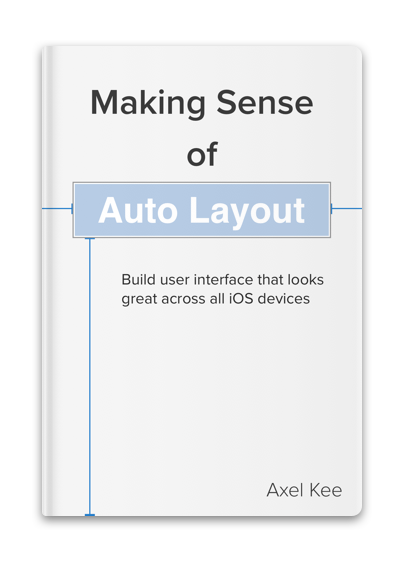There's a popular trend in recent iOS apps which when user tap a button, a card-like modal will appear from the bottom and user can drag to expand, contract, or dismiss it. Facebook and Slack app uses this UI design :

In this tutorial, we will analyze how to implement the bottom card modal, and try to replicate it using modal presentation (ie. self.present(CardViewController)) , Pan Gesture, Storyboard and Auto Layout. This post assume you have some experience working with Auto Layout. There's other ways to do this such as implementing a custom UIViewController Transition
The end result (with dimming and draggable bottom modal) will look like this :
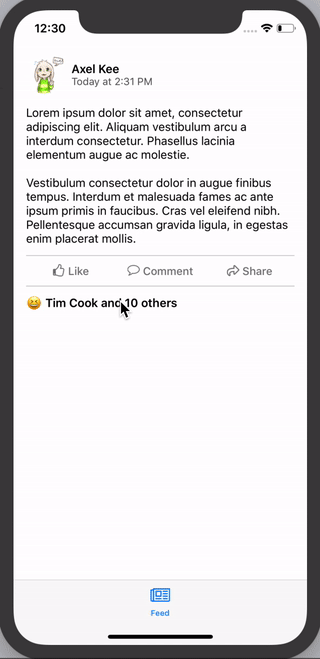
As the focus of this tutorial is implementing the bottom card modal view (not the Fake facebook status view shown above), I have created a starter project which contain the fake Facebook status view, you can get the starter project below :
https://drive.google.com/file/d/1XktE9ZGey8vc0-Xf2y_uQwujI-2m3sVr/view?usp=sharing
The starter project contains a fake Facebook Status View Controller (Status View Controller) embedded inside a tab bar controller.
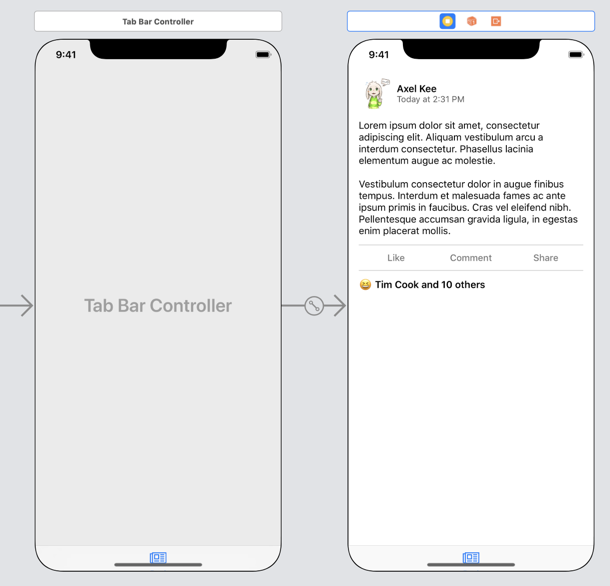
You can use your own view / view controller if you don't want to use the facebook status view design. As long as your own View Controller has a UIButton that can activate the modal view controller on tap, the tutorial steps can be applied.
Build and run the starter project and you will see the fake Facebook Status View, tapping the "😆 Tim Cook and 10 others" button will call the reactionListButtonTapped() function inside StatusViewController.swift .
Big picture of what we are gonna do in this tutorial
For the bottom modal card, we will create a view controller for it. Here's the big picture of the 7 main steps of this tutorial :
Step 1: Create a new view controller (I named it as 'ReactionViewController', with a Storyboard ID of 'ReactionViewController' as well). Then the StatusViewController will present this new view controller modally, without animation.

Step 2: Add an UIImageView to the Reaction View Controller, and pin it to the top, bottom, leading and trailing edges. Note that the top constraint is towards "Superview's Top" (the absolute top of the screen), not the safe area, same goes to the bottom constraint.

Step 3: Take snapshot of the StatusViewController (Fake Facebook Status View), which is an UIImage, and set the image view in ReactionViewController to use this snapshot image, to give an illusion of transition.

Step 4: Add a gray UIView (with alpha 0.7 ish) on top of the image view, to serve as a dimmer view. Add a tap gesture recognizer on this gray view, when user tap on it, dismiss the ReactionViewController to go back to the StatusViewController.

Step 5: Add a white UIView on top of the gray dimmer view, round the top left and top right corners. This is the card view we will use to display content. Create an IBOutlet for the top constraint from the card view top to the Safe Area Top.

Step 6: Add a pan gesture recognizer on the ReactionViewController root view (i.e self.view) , and use code to change the top constraint constant value based on the distance panned by the user. i.e: when user drag finger up, the card view will expand upwards, when user drag finger down, the card view will contract downwards.

Step 7: Add the handle view on top of the card view and also any additional content on the card as you like!

There's all to it! Most of the complex coding is on step 6 (manipulating the top constraint constant value based on the pan gesture).
Without further ado, let's start the tutorial!
Create ReactionViewController with backing Image View and gray dimmer View
Open the starter project, create a new ViewController file , and name it as "ReactionViewController". Next, open the Main.storyboard, drag a new view controller into the storyboard, set its class to ReactionViewController and set its Storyboard ID to 'ReactionViewController' (same name as the class).
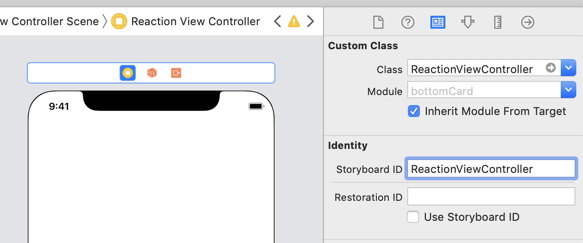
Next, open "StatusViewController.swift", find the function @IBAction func reactionListButtonTapped(). This function is fired when the "Tim Cook and 10 others" reaction button on the status view is tapped.
We want to present the ReactionViewController modally when this button is tapped, add the following code inside the function :
@IBAction func reactionListButtonTapped(_ sender: UIButton) {
guard let reactionVC = storyboard?.instantiateViewController(withIdentifier: "ReactionViewController")
as? ReactionViewController else {
assertionFailure("No view controller ID ReactionViewController in storyboard")
return
}
// set the modal presentation to full screen, in iOS 13, its no longer full screen by default
reactionVC.modalPresentationStyle = .fullScreen
// present the view controller modally without animation
self.present(reactionVC, animated: false, completion: nil)
}
If we present a view controller modally with animated set to true, iOS will use a default animation of moving the new controller from the bottom edge to the top. We don't want this animation as we are going to replace it with our own card modal animation.
Build and run the project, when you tap on the button, you will see a blank view controller appear immediately like this :
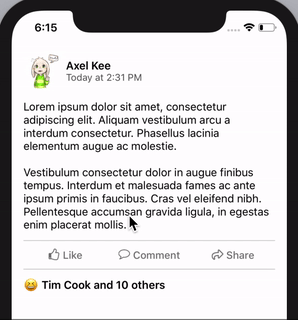
As the blank view controller looks very different than the previous view controller, this might give user a sudden shock. To smoothen the transition, we will take a snapshot of the previous view controller, and put the snapshot image as the background of the new view controller (ReactionViewController), so that user won't notice that there is a transition of view controllers.
To capture an image snapshot of a view, we will use UIGraphicsImageRenderer class provided by Apple to render the UIView as an image. Create a new Swift file, name it as "UIView+Snapshot.swift", then add an extension to the UIView class like this :
// UIView+Snapshot.swift
import UIKit
extension UIView {
// render the view within the view's bounds, then capture it as image
func asImage() -> UIImage {
let renderer = UIGraphicsImageRenderer(bounds: bounds)
return renderer.image({ rendererContext in
layer.render(in: rendererContext.cgContext)
})
}
}
Next, we will place an UIImageView on the ReactionViewController, this image view will use the image snapshot we captured earlier on. Drag an UIImageView into ReactionViewController, then set top, bottom, leading and trailing constraint to 0 like this :

By default Xcode will set the top and bottom constraint to the Safe Area (the rectangular area not hidden by the notch and rounded corner of the phone screen). We want the image view to cover the whole screen including the rounded corner of the phone screen, to do this, open the Size inspector tab to list all constraints for the image view.
Double click the Top constraint:
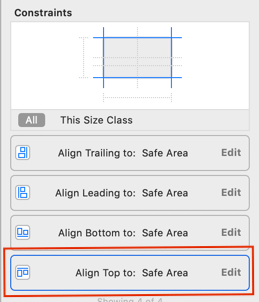
In the First Item or Second Item, change the SafeArea.Top to SuperView.Top, and after changing, set the constant to 0.

Do the same for the bottom constraint, change the SafeArea.Bottom to SuperView.Bottom, and set the constant to 0.
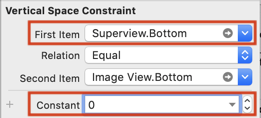
After setting both top and bottom constraint to compare against superview, the UIImageView should look like this in the view controller :
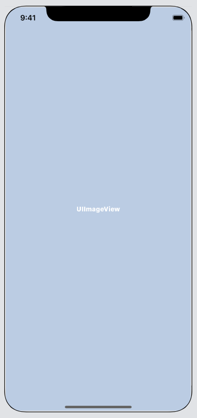
Next, create an IBOutlet for this image view, an declare an UIImage variable to store the snapshot image, in ReactionViewController.swift :
// ReactionViewController.swift
class ReactionViewController: UIViewController {
@IBOutlet weak var backingImageView: UIImageView!
// to store backing (snapshot) image
var backingImage: UIImage?
override func viewDidLoad() {
super.viewDidLoad()
// update the backing image view
backingImageView.image = backingImage
}
}
Don't forget to update the imageview's image in viewDidLoad as well.
Now in the StatusViewController, we can capture the snapshot of its view right when the button is tapped, instantiate the ReactionViewController, and pass the snapshot image to the backingImage variable.
// StatusViewController.swift
@IBAction func reactionListButtonTapped(_ sender: UIButton) {
guard let reactionVC = storyboard?.instantiateViewController(withIdentifier: "ReactionViewController")
as? ReactionViewController else {
assertionFailure("No view controller ID ReactionViewController in storyboard")
return
}
// take a snapshot of current view and set it as backingImage
reactionVC.backingImage = self.view.asImage()
// present the view controller modally without animation
self.present(reactionVC, animated: false, completion: nil)
}
Build and run the project, tap the button and you will see that nothing has changed after tapping button, it means that the snapshot image is being shown correctly! The ReactionViewController has presented modally and its backing image view is using the snapshot captured on StatusViewController.
Upon closer inspection, the snapshotted image didn't have tab bar?! 😱
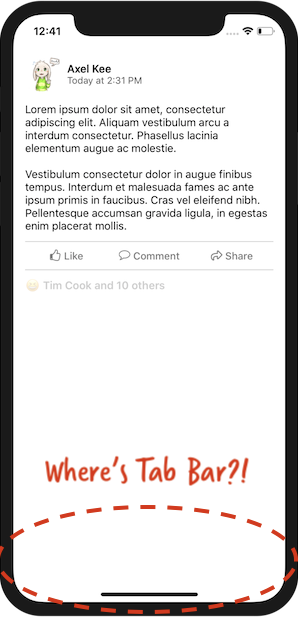
The snapshot from self.view.asImage() in StatusViewController doesn't contain tab bar, this is because StatusViewController is embedded inside Tab Bar Controller, hence calling capture on itself doesn't capture UI outside of its bounds. To fix this, we should call self.tabBarController?.view.asImage() instead, to capture the whole view including tab bar.
// StatusViewController.swift
@IBAction func reactionListButtonTapped(_ sender: UIButton) {
guard let reactionVC = storyboard?.instantiateViewController(withIdentifier: "ReactionViewController") as? ReactionViewController else {
assertionFailure("No view controller ID ReactionViewController in storyboard")
return
}
// capture the whole view including tab bar
reactionVC.backingImage = self.tabBarController?.view.asImage()
self.present(reactionVC, animated: false, completion: nil)
}
Build and run the project again, this time the tab bar is there after pressing the button! But wait, the button seems faded out?
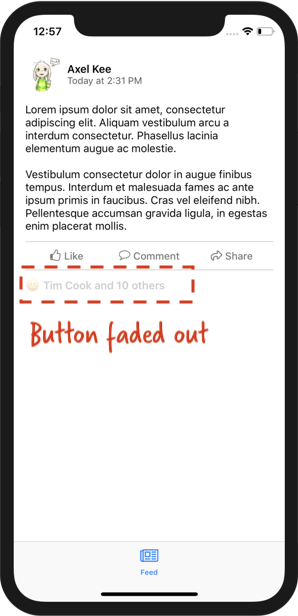
On default UIKit setting, when a button is being tapped, it will fade out for a while before restoring back the original opacity. As the snapshot is captured immediately right after user tap the button, the button is still in its faded out state during the capture.
One of the way to solve this is to delay the capture of the snapshot and subsequently the modal presentation, we can use DispatchQueue to delay the execution of screen capture like this :
// StatusViewController.swift
@IBAction func reactionListButtonTapped(_ sender: UIButton) {
guard let reactionVC = storyboard?.instantiateViewController(withIdentifier: "ReactionViewController")
as? ReactionViewController else {
assertionFailure("No view controller ID ReactionViewController in storyboard")
return
}
// Delay the capture of snapshot by 0.1 seconds
DispatchQueue.main.asyncAfter(deadline: .now() + 0.1 , execute: {
// take a snapshot of current view and set it as backingImage
reactionVC.backingImage = self.tabBarController?.view.asImage()
// present the view controller modally without animation
self.present(reactionVC, animated: false, completion: nil)
})
}
Build and run the project, now we have implemented an illusion which user feel like they are still on the same view controller despite ReactionViewController has been presented modally!
Next, we will put a dimmer view on top of the backing image view in ReactionViewController. Apply the same top, bottom (to superview instead of safe area), leading and trailing constraints for the dimmer view as well.
Set the background color of the dimmer view to Dark Gray (or any other darker color you want), then set the alpha to 0.7 . Your storyboard should look like this now :
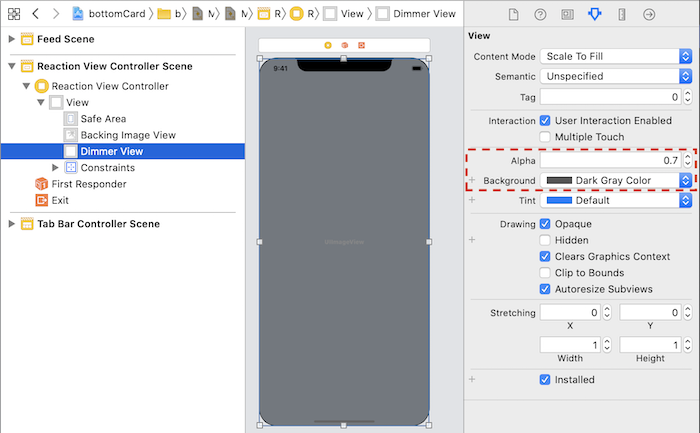
Next, create an IBOutlet for this dimmer view in ReactionViewController, we can name it as dimmerView .
// ReactionViewController.swift
class ReactionViewController: UIViewController {
@IBOutlet weak var backingImageView: UIImageView!
@IBOutlet weak var dimmerView: UIView!
// to store backing (snapshot) image
var backingImage: UIImage?
// ...
}
Adding the card view
Now we have the dimmer view, it's time to put the actual card view on the ReactionViewController. Drag a new UIView onto the view controller, place it on top of the dimmer view, then add the constraints like this :
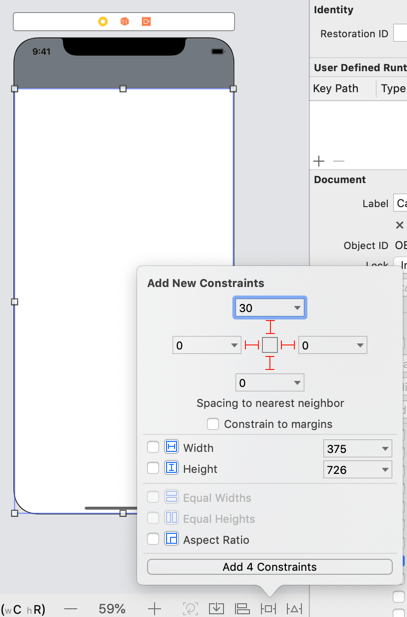
The bottom constraint of the card view should be relative to the Superview bottom (same as previous dimmer view), but the top constraint of the card view should be relative to the SafeArea top, and with a constant number (I have set it to 30) :
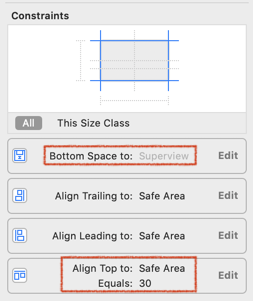
Next, create an IBOutlet for the card view and the top constraint of the card view, you can name the IBOutlet for the card view as cardView.
To create an IBOutlet for the top constraint, double click the top constraint in the constraint list, then Xcode will highlight the constraint on the Document Outline, then press and hold Control and drag it to the view controller's code.
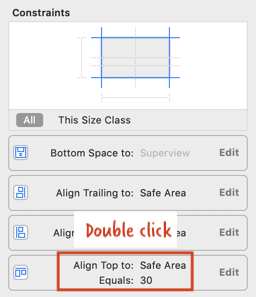
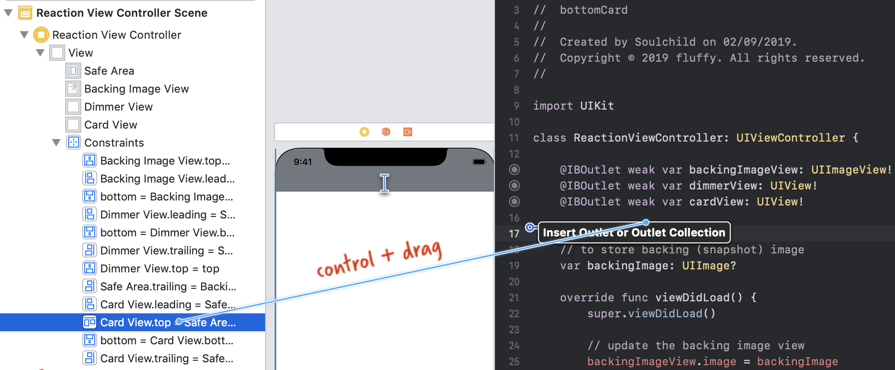
I have named the top constraint IBOutlet as cardViewTopConstraint . Your ReactionViewController.swift file should look like this now :
// ReactionViewController
class ReactionViewController: UIViewController {
@IBOutlet weak var backingImageView: UIImageView!
@IBOutlet weak var dimmerView: UIView!
@IBOutlet weak var cardView: UIView!
@IBOutlet weak var cardViewTopConstraint: NSLayoutConstraint!
// to store backing (snapshot) image
var backingImage: UIImage?
override func viewDidLoad() {
super.viewDidLoad()
// update the backing image view
backingImageView.image = backingImage
}
}
As the top left and top right corner of the card view is rounded, we can round them like this :
// ReactionViewController.swift
override func viewDidLoad() {
super.viewDidLoad()
// update the backing image view
backingImageView.image = backingImage
// round the top left and top right corner of card view
cardView.clipsToBounds = true
cardView.layer.cornerRadius = 10.0
cardView.layer.maskedCorners = [.layerMinXMinYCorner, .layerMaxXMinYCorner]
}
Now build and run the project, tap the button, you will see the card view presented suddenly with dimmer view. Next, we want the card view to appear from the bottom smoothly and the dimmer view slowly become darker when the button is tapped.
Before proceeding to the code, let's take a look at the card view. There's two state for the card, I will name them as .normal and .expanded. Here's the top constraint value for when the card is expanded, normal and hidden (it is placed below the screen area before moving up) :

When user tap on the button, the card should be hidden at bottom at first, then slowly move up. Same goes to the dimmer view, the view should slowly transition from transparent to gray dim.
Let's move the card to below the screen and set the dimmer view to transparent like this :
// ReactionViewController.swift
override func viewDidLoad() {
super.viewDidLoad()
// update the backing image view
backingImageView.image = backingImage
// round the top left and top right corner of card view
cardView.clipsToBounds = true
cardView.layer.cornerRadius = 10.0
cardView.layer.maskedCorners = [.layerMinXMinYCorner, .layerMaxXMinYCorner]
// hide the card view at the bottom when the View first load
if let safeAreaHeight = UIApplication.shared.keyWindow?.safeAreaLayoutGuide.layoutFrame.size.height,
let bottomPadding = UIApplication.shared.keyWindow?.safeAreaInsets.bottom {
cardViewTopConstraint.constant = safeAreaHeight + bottomPadding
}
// set dimmerview to transparent
dimmerView.alpha = 0.0
}
We make the top constraint constant value of the card view to equal to safe area height + bottom insets of safe area, so that the card will be hidden below.
Next, we are going to implement the animation where the card move up from the bottom to the .normal state, and the dimmer view become dim (gray, alpha = 1.0) from transparent. This animation is shown when the ReactionViewController's view appears, hence we will put the animation code in viewDidAppear().
// ReactionViewController.swift
override func viewDidAppear(_ animated: Bool) {
super.viewDidAppear(animated)
showCard()
}
//MARK: Animations
private func showCard() {
// move card up from bottom
// show dimmer view
}
Next, we are going to implement the animations in showCard() function using Property Animators .
// ReactionViewController.swift
//MARK: Animations
private func showCard() {
// ensure there's no pending layout changes before animation runs
self.view.layoutIfNeeded()
// set the new top constraint value for card view
// card view won't move up just yet, we need to call layoutIfNeeded()
// to tell the app to refresh the frame/position of card view
if let safeAreaHeight = UIApplication.shared.keyWindow?.safeAreaLayoutGuide.layoutFrame.size.height,
let bottomPadding = UIApplication.shared.keyWindow?.safeAreaInsets.bottom {
// when card state is normal, its top distance to safe area is
// (safe area height + bottom inset) / 2.0
cardViewTopConstraint.constant = (safeAreaHeight + bottomPadding) / 2.0
}
// move card up from bottom by telling the app to refresh the frame/position of view
// create a new property animator
let showCard = UIViewPropertyAnimator(duration: 0.25, curve: .easeIn, animations: {
self.view.layoutIfNeeded()
})
// show dimmer view
// this will animate the dimmerView alpha together with the card move up animation
showCard.addAnimations({
self.dimmerView.alpha = 0.7
})
// run the animation
showCard.startAnimation()
}
Before animating the position change of card view, we first need to execute self.view.layoutIfNeeded() to implement any pending layout change (eg: view' s frame update due to constraint changes).
Then we modify the card view top constraint constant value from safeAreaHeight + bottomPadding (hidden at the bottom) to (safeAreaHeight + bottomPadding) / 2.0 , which makes it occupies around half the height of the screen.
Changing the constraint value won't move the card view up immediately, we need to call self.view.layoutIfNeeded() to tell the app to update the frame / position of the card view (and any other views inside the view controller), we want the position change to be animated , hence we will create a UIViewPropertyAnimator object and place layoutIfNeeded() inside it.
We also want to add the dimmer view alpha transition animation parallel to the card movement animation, to perform both of them at the same time, we will add the alpha animation to the showCard property animator using addAnimations().
Then at last, we run the animation by calling startAnimation().
Build and run the project, tap the button and you will see the card view appear from bottom + background dimming like this :
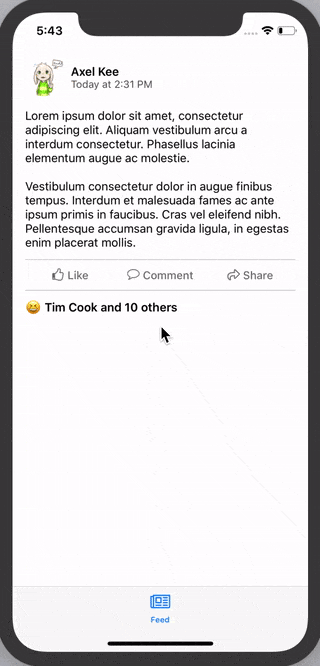
Looks nifty , isn't it? But now we are stuck on this screen as there is no way to dismiss the card 😅, let's add a dismissing function to it.
In Facebook app, we can dismiss the card view by tapping on the background (dimmer view). Let's replicate this by adding a tap gesture to the dimmer view, and dismiss ReactionViewController when it is being tapped.
Let's start by adding a tap gesture recognizer to the dimmer view in viewDidLoad() :
// ReactionViewController.swift
override func viewDidLoad() {
super.viewDidLoad()
// .....
// dimmerViewTapped() will be called when user tap on the dimmer view
let dimmerTap = UITapGestureRecognizer(target: self, action: #selector(dimmerViewTapped(_:)))
dimmerView.addGestureRecognizer(dimmerTap)
dimmerView.isUserInteractionEnabled = true
}
// @IBAction is required in front of the function name due to how selector works
@IBAction func dimmerViewTapped(_ tapRecognizer: UITapGestureRecognizer) {
hideCardAndGoBack()
}
//MARK: Animations
private func showCard(){
//...
}
private func hideCardAndGoBack() {
// implement card moving downward animation
// implement dimmer view fade out animation
// dismiss current view controller
}
When the dimmer view is tapped, the dimmerViewTapped() function will be called and it will call hideCardAndGoBack().
Next, we will implement the card hiding animation.
// ReactionViewController.swift
private func hideCardAndGoBack() {
// ensure there's no pending layout changes before animation runs
self.view.layoutIfNeeded()
// set the new top constraint value for card view
// card view won't move down just yet, we need to call layoutIfNeeded()
// to tell the app to refresh the frame/position of card view
if let safeAreaHeight = UIApplication.shared.keyWindow?.safeAreaLayoutGuide.layoutFrame.size.height,
let bottomPadding = UIApplication.shared.keyWindow?.safeAreaInsets.bottom {
// move the card view to bottom of screen
cardViewTopConstraint.constant = safeAreaHeight + bottomPadding
}
// move card down to bottom
// create a new property animator
let hideCard = UIViewPropertyAnimator(duration: 0.25, curve: .easeIn, animations: {
self.view.layoutIfNeeded()
})
// hide dimmer view
// this will animate the dimmerView alpha together with the card move down animation
hideCard.addAnimations {
self.dimmerView.alpha = 0.0
}
// when the animation completes, (position == .end means the animation has ended)
// dismiss this view controller (if there is a presenting view controller)
hideCard.addCompletion({ position in
if position == .end {
if(self.presentingViewController != nil) {
self.dismiss(animated: false, completion: nil)
}
}
})
// run the animation
hideCard.startAnimation()
}
The code is similar to the show card animation, except that this time we are changing the top constraint value of card view to safeAreaHeight + bottomPadding, to push the card view to the bottom of the screen.
We also set and animate the dimmerView alpha to 0.0 (transparent) to hide it.
We add a completion function to the animation, which tells it to dismiss the current view controller (if there is a presenting view controller, ie. the StatusViewController that presented the current ReactionViewController) after the animation has ended (position == .end).
Build and run the app, now you can dismiss the card view (ReactionViewController) by tapping on the background (dimmer view)! It's starting to look good! 🌟
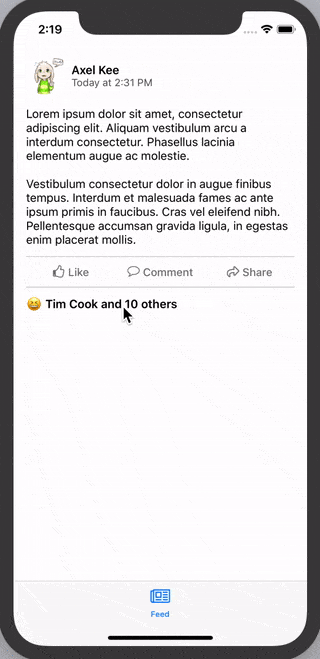
Phew, this is a long post to write, and also give yourself a pat on the back for following until this step! In the next part, we will implement the drag to expand / hide + swipe down quickly to hide mechanism, you can read the next part here : https://fluffy.es/facebook-draggable-bottom-card-modal-2/
In a hurry or dont want to spend a lot of time implementing the steps? Dive in the completed project and try it out yourself!
Get the completed project ($)
